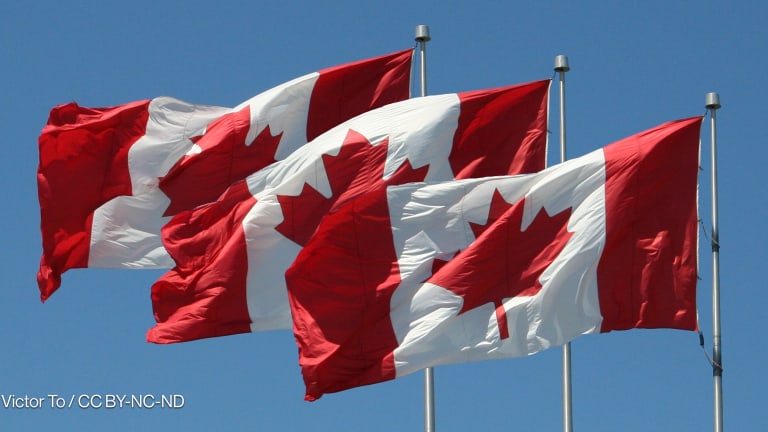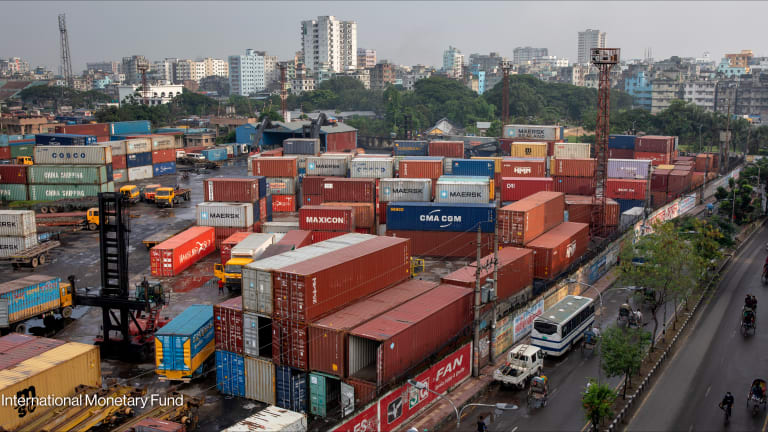How much ODA reaches low- and middle-income countries?
The data suggests that less than half of the total bilateral ODA goes to projects that the recipient countries can manage. The bulk still goes to non-project-type interventions, such as debt relief and in-donor refugee costs.
Official development assistance, or ODA, has long been used to measure aid flow from bilateral donors to recipient countries. But the way it is reported makes it difficult to gauge how much of it is directed towards development in low- and middle-income countries. As a result, the Organisation for Economic Co-operation and Development, which sets the standard for ODA, developed a new method in 2007, to have a better estimate of the amount of money that flows into recipient countries. That was country programmable aid or CPA. In 2021, total ODA was $184.9 million. Of that $143.8 billion was bilateral ODA, and of that, only $65 billion was spent on CPA. Why a new measure? Not all aid goes to social and economic projects. It can be diverted to many other sources. Broadly speaking, ODA is categorized as either bilateral aid or multilateral aid. Multilateral aid covers core funding to institutions such as United Nations agencies and the World Bank. Everything else counts as bilateral aid, including earmarked contributions to the same institutions — when aid intended for a specific activity is implemented by a multilateral agency on behalf of a bilateral donor. A significant portion of bilateral aid goes to areas that are either “not fully transparent to or cannot be managed by the recipient countries.” This includes humanitarian and food aid, debt relief, core funding to nongovernmental organizations, administrative costs, and in-donor refugee costs. If we exclude these expenditures, what’s left is CPA. In this article, we’ll look into how much the Development Assistance Committee member countries spent on CPA between 2017 and 2021 based on the data from the OECD. We also compared their CPA spending with their overall bilateral aid spending. Finally, we looked into the top recipients of CPA among low- and middle-income countries. All figures are in 2021 constant prices. What is CPA and what is included under this headline? The majority of CPA is spent on projects. But other expenditures, such as technical assistance, budget support, and core contributions and pooled programs and funds, which are not programmable, still fall under CPA. The exact breakdown of CPA is not reported on OECD Statistics, but an overview of what consists of the total bilateral ODA in 2021, based on the preliminary data can be accessed through each of the DAC donors’ profiles on OECD’s main website. <div class='tableauPlaceholder' id='viz1711602709673' style='position: relative'><noscript><a href='#'><img alt='Total CPA by donor ' src='https://public.tableau.com/static/images/Co/Countryprogrammableaidbydonor2017to2021/TotalCPAbydonor/1_rss.png' style='border: none' /></a></noscript><object class='tableauViz' style='display:none;'><param name='host_url' value='https%3A%2F%2Fpublic.tableau.com%2F' /> <param name='embed_code_version' value='3' /> <param name='site_root' value='' /><param name='name' value='Countryprogrammableaidbydonor2017to2021/TotalCPAbydonor' /><param name='tabs' value='no' /><param name='toolbar' value='no' /><param name='static_image' value='https://public.tableau.com/static/images/Co/Countryprogrammableaidbydonor2017to2021/TotalCPAbydonor/1.png' /> <param name='animate_transition' value='yes' /><param name='display_static_image' value='yes' /><param name='display_spinner' value='yes' /><param name='display_overlay' value='yes' /><param name='display_count' value='yes' /><param name='showShareOptions' value='false' /><param name='toolbar' value='no' /></object></div> <script type='text/javascript'> var divElement = document.getElementById('viz1711602709673'); var vizElement = divElement.getElementsByTagName('object')[0]; if ( divElement.offsetWidth > 800 ) { vizElement.style.width='600px';vizElement.style.minHeight='900px';vizElement.style.maxHeight='1700px';vizElement.style.height=(divElement.offsetWidth*0.75)+'px';} else if ( divElement.offsetWidth > 500 ) { vizElement.style.width='600px';vizElement.style.minHeight='900px';vizElement.style.maxHeight='1700px';vizElement.style.height=(divElement.offsetWidth*0.75)+'px';} else { vizElement.style.width='100%';vizElement.style.height='850px';} var scriptElement = document.createElement('script'); scriptElement.src = 'https://public.tableau.com/javascripts/api/viz_v1.js'; vizElement.parentNode.insertBefore(scriptElement, vizElement); </script> <i style=font-style: georgia;”>Country programmable aid by donor from 2017 to 2021, based on OECD.</i> The overview shows that about 76.6% of the $65 billion CPA in 2021, worth $47.6 billion, went to project-type interventions. The rest went to other expenditures, including: • Budget support, with $6 billion. • Core contributions and pooled programs and funds, with $5.2 billion. • Technical assistance, with $2.7 billion. • Scholarships and other costs for students from low- and middle-income countries in donor countries, with $601.1 million. Trends in CPA spending CPA was $63.4 billion in 2017, $62.5 billion in 2018, then $60.7 billion in 2019. It rose to $67.1 billion in 2020 — the first year of the COVID-19 pandemic — then slipped to $65 billion the following year. Our analysis shows that less than half of the total bilateral aid from DAC donors during the five-year period was CPA. The highest percentage was in 2020, with 49.2% of bilateral ODA being CPA, while the lowest rate was in 2021, at 45.2%. Of the 31 DAC member countries, just nine donors — or less than a third — spent more than half of their bilateral aid between 2017 and 2019 on CPA. In 2017, these donors were Australia, Czech Republic, France, Hungary, Japan, Luxembourg, New Zealand, Portugal, and South Korea. Poland, the Slovak Republic, Estonia, and Lithuania all spent more than half their income on CPA in at least one year. Across all years, Hungary maintained its rank as the top spender on CPA relative to its total bilateral aid. In 2021, Hungary spent $232.9 million on CPA — 92% of its bilateral aid. Other donors also spent significantly on CPA in 2021 relative to their bilateral ODA. This includes: • South Korea — nearly $2 billion, or 80.5% of its bilateral aid. • Japan — $14.2 billion, or 79.7% of its bilateral aid. • New Zealand — $432.6 million, or 74.7%. • Australia — $2.3 billion, or 74.4%. • Slovak Republic — $24.6 million, or 67.2%. Japan was the top spender on CPA in 2021 in monetary terms. The other donors followed: • United States — $13.9 billion. • Germany — $10.8 billion. • France — $8.4 billion. • United Kingdom — $3.1 billion. • Australia — $2.3 billion. Who’s receiving the most CPA? In monetary terms, India was the top recipient of CPA from 2017 to 2021. From $4.1 billion in 2017, its CPA rose to $4.7 billion in 2021. During the five-year period, its CPA-to-bilateral ODA ratio was between 87.6% and 93.4%. <div class='tableauPlaceholder' id='viz1711603076710' style='position: relative'><noscript><a href='#'><img alt='Geographical distribution of CPA ' src='https://public.tableau.com/static/images/Ge/GeographicaldistributionofCPAfrom2017to2021/GeographicaldistributionofCPA/1_rss.png' style='border: none' /></a></noscript><object class='tableauViz' style='display:none;'><param name='host_url' value='https%3A%2F%2Fpublic.tableau.com%2F' /> <param name='embed_code_version' value='3' /> <param name='site_root' value='' /><param name='name' value='GeographicaldistributionofCPAfrom2017to2021/GeographicaldistributionofCPA' /><param name='tabs' value='no' /><param name='toolbar' value='no' /><param name='static_image' value='https://public.tableau.com/static/images/Ge/GeographicaldistributionofCPAfrom2017to2021/GeographicaldistributionofCPA/1.png' /> <param name='animate_transition' value='yes' /><param name='display_static_image' value='yes' /><param name='display_spinner' value='yes' /><param name='display_overlay' value='yes' /><param name='display_count' value='yes' /><param name='showShareOptions' value='false' /></object></div> <script type='text/javascript'> var divElement = document.getElementById('viz1711603076710'); var vizElement = divElement.getElementsByTagName('object')[0]; if ( divElement.offsetWidth > 800 ) { vizElement.style.width='600px';vizElement.style.minHeight='900px';vizElement.style.maxHeight='1700px';vizElement.style.height=(divElement.offsetWidth*0.75)+'px';} else if ( divElement.offsetWidth > 500 ) { vizElement.style.width='600px';vizElement.style.minHeight='900px';vizElement.style.maxHeight='1700px';vizElement.style.height=(divElement.offsetWidth*0.75)+'px';} else { vizElement.style.width='100%';vizElement.style.height='950px';} var scriptElement = document.createElement('script'); scriptElement.src = 'https://public.tableau.com/javascripts/api/viz_v1.js'; vizElement.parentNode.insertBefore(scriptElement, vizElement); </script> <i style=font-style: georgia;”>Geographical distribution of country programmable aid from 2017 to 2021, based on OECD.</i> Bangladesh ranked next, with nearly $3 billion CPA in 2021. The country had a flat trend between 2017 and 2019, but experienced a significant leap in 2020, with $2.8 billion compared to $2.1 billion in the previous year. The Philippines was also among the lead recipients of CPA, with almost $2 billion in 2021. The Asia-Pacific country just had about $639 million of CPA in 2017, but recorded a steady increase in the following years. Other top CPA recipients in 2021 were Indonesia, with $1.7 billion, Colombia, with $1.5 billion, Afghanistan, with $1.5 billion, Jordan, with $1.4 billion, and Morocco, with $1.3 billion. Our data also reveals that small island developing states, or SIDS, and overseas countries and territories, or OCTs, tend to have a higher CPA-to-bilateral ODA ratio. Among them, Wallis and Futuna and Niue both had 100% of their bilateral ODA in 2021 disbursed as CPA. Other SIDS, including Polynesia, Nauru, and Micronesia, received over 99% of their bilateral ODA as CPA. Try out Devex Pro Funding today with a free five-day trial, and explore funding opportunities from over 850 sources in addition to our analysis and news content.
Official development assistance, or ODA, has long been used to measure aid flow from bilateral donors to recipient countries.
But the way it is reported makes it difficult to gauge how much of it is directed towards development in low- and middle-income countries.
As a result, the Organisation for Economic Co-operation and Development, which sets the standard for ODA, developed a new method in 2007, to have a better estimate of the amount of money that flows into recipient countries.
This story is forDevex Promembers
Unlock this story now with a 15-day free trial of Devex Pro.
With a Devex Pro subscription you'll get access to deeper analysis and exclusive insights from our reporters and analysts.
Start my free trialRequest a group subscription Printing articles to share with others is a breach of our terms and conditions and copyright policy. Please use the sharing options on the left side of the article. Devex Pro members may share up to 10 articles per month using the Pro share tool ( ).
Miguel Tamonan is a Senior Development Analyst at Devex, where he analyzes data from public and private donors to produce content and special reports for Pro and Pro Funding readers. He has a bachelor’s degree in Political Science with a Major in International Relations from the Polytechnic University of the Philippines.








